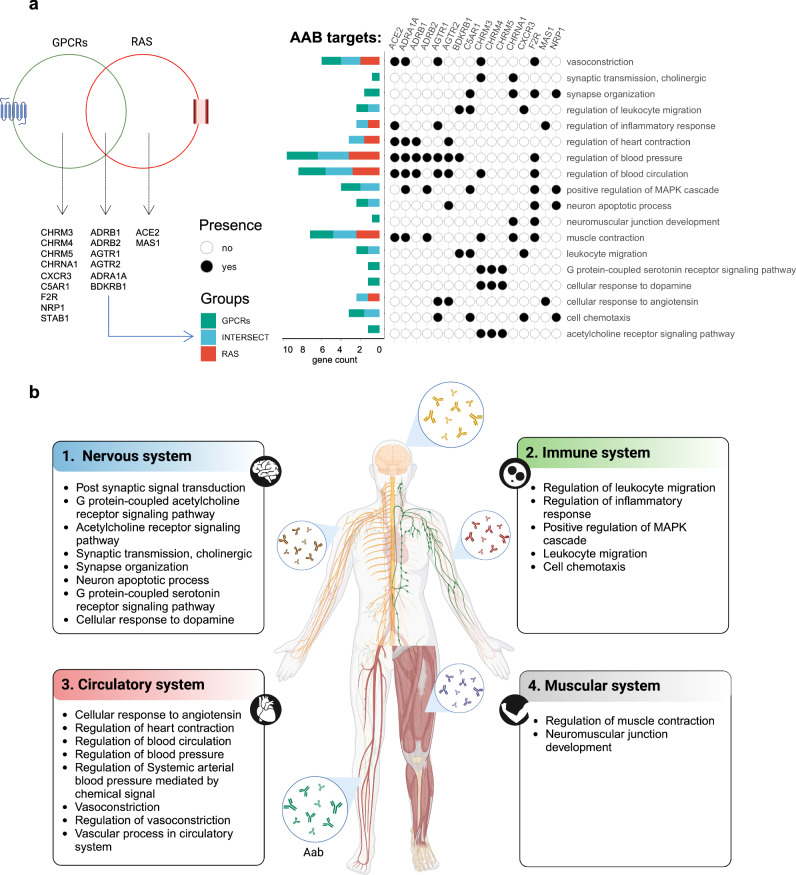Dysregulated autoantibodies targeting AGTR1 are associated with the accumulation of COVID-19 symptoms.
Coronavirus disease 2019 (COVID-19) presents a wide spectrum of symptoms, the causes of which remain poorly understood. This study explored the associations between autoantibodies (AABs), particularly those targeting G protein-coupled receptors (GPCRs) and renin‒angiotensin system (RAS) molecules, and the clinical manifestations of COVID-19. Using a cross-sectional analysis of 244 individuals, we applied multivariate analysis of variance, principal component analysis, and multinomial regression to examine the relationships between AAB levels and key symptoms. Significant correlations were identified between specific AABs and symptoms such as fever, muscle aches, anosmia, and dysgeusia. Notably, anti-AGTR1 antibodies, which contribute to endothelial glycocalyx (eGC) degradation, a process reversed by losartan, have emerged as strong predictors of core symptoms. AAB levels increased with symptom accumulation, peaking in patients exhibiting all four key symptoms. These findings highlight the role of AABs, particularly anti-AGTR1 antibodies, in determining symptom severity and suggest their involvement in the pathophysiology of COVID-19, including vascular complications.
Authors
Fonseca DLM, Jäpel M, Gyamfi MA, Filgueiras IS, Baiochi GC, et al.
External link
Publication Year
Publication Journal
Associeted Project
Systems Immunology of Human Diseases
Lista de serviços
-
RASL11A, member of a novel small monomeric GTPase gene family, is down-regulated in prostate tumors.RASL11A, member of a novel small monomeric GTPase gene family, is down-regulated in prostate tumors.
-
Splice variants of TLE family genes and up-regulation of a TLE3 isoform in prostate tumors.Splice variants of TLE family genes and up-regulation of a TLE3 isoform in prostate tumors.
-
Concepts on Microarray Design for Genome and Transcriptome AnalysesConcepts on Microarray Design for Genome and Transcriptome Analyses
-
The iron stimulon of Xylella fastidiosa includes genes for type IV pilus and colicin V-like bacteriocins.The iron stimulon of Xylella fastidiosa includes genes for type IV pilus and colicin V-like bacteriocins.
-
Origins of the Xylella fastidiosa prophage-like regions and their impact in genome differentiation.Origins of the Xylella fastidiosa prophage-like regions and their impact in genome differentiation.
-
The role of prophage in plant-pathogenic bacteria.The role of prophage in plant-pathogenic bacteria.
-
Genetic control of immune response and susceptibility to infectious diseases.Genetic control of immune response and susceptibility to infectious diseases.
-
Building capacity for advances in tuberculosis research; proceedings of the third RePORT international meeting.Building capacity for advances in tuberculosis research; proceedings of the third RePORT international meeting.
-
São Paulo School of Advanced Sciences on Vaccines: an overview.São Paulo School of Advanced Sciences on Vaccines: an overview.
-
A reasonable request for true data sharing.A reasonable request for true data sharing.

